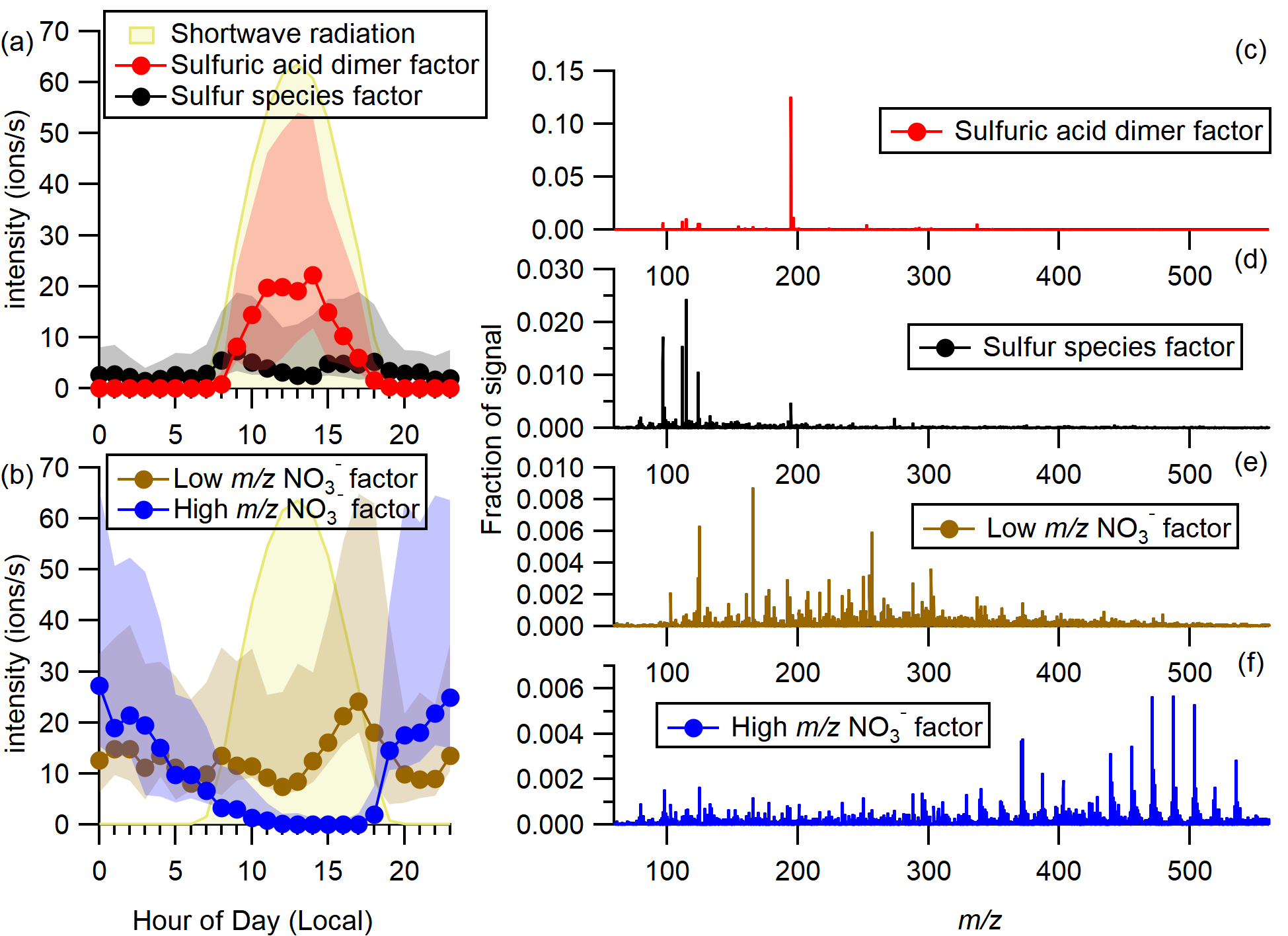Insight into particle formation and growth precursors during HI-SCALE
Submitter
Browne, Eleanor — University of Colorado Boulder
Katz, Daniel John
— University of Colorado Boulder
Area of Research
Aerosol Processes
Journal Reference
Katz D, A Abdelhamid, H Stark, M Canagaratna, D Worsnop, and E Browne. 2023. "Chemical identification of new particle formation and growth precursors through positive matrix factorization of ambient ion measurements." Atmospheric Chemistry and Physics, 23(9), 10.5194/acp-23-5567-2023.
Science

Figure 1. (a) Hourly diel plots of the HSO4- factors and shortwave radiation over the whole campaign. Markers represent median values, and shaded regions show the range between the first and third quartiles. (b) Hourly diel plots of the two NO3- factors over the whole campaign. (c–f) Mass spectra of the four factors. Note that the scale of the y axes varies in (c)–(f). From journal.
We measured the chemical composition of ambient ion clusters as part of the 2016 Holistic Interactions of Shallow Clouds and Aerosols Campaign (HI-SCALE) at the U.S. Department of Energy (DOE) Atmospheric Radiation Measurement (ARM) user facility's Southern Great Plains (SGP) observatory in Oklahoma. The measurements provide insight into reactive carbon and nitrogen compounds, particularly those thought to be important for new particle formation and growth.
Impact
Unlike other locations where monoterpene oxidation products account for the majority of highly oxidized organic molecules, here we find evidence that sesquiterpene emissions are important. Moreover, nitrate radical oxidation of sesquiterpenes appears to be a major source of these oxidized molecules. These compounds represent an underappreciated source of organic aerosol in agricultural areas. The novel combination of techniques we use to analyze the data – binned positive matrix factorization and generalized Kendrick analysis – can be widely applied to chemically characterize complicated mass spectral data, especially low signal-to-noise data sets.
Summary
In the lower troposphere negative charges are transferred to the most acidic species, which are thought to be important for new particle formation and growth. We measured ambient ion clusters using an atmospheric pressure interface time-of-flight mass spectrometer (APi-ToF) during the 2016 HI-SCALE campaign at the DOE ARM SGP atmospheric observatory, an agricultural region. We use binned positive matrix factorization (binPMF) and generalized Kendrick analysis (GKA) to constrain the chemical composition and reveal rapid-timescale variation of ions. Negative ions consist of strong acids including sulfuric and nitric acid, organosulfates, and clusters of NO3- with highly oxygenated organic molecules (HOMs) derived from monoterpene (MT) and sesquiterpene (SQT) oxidation. Organonitrates derived from SQTs account for most of the HOM signal and likely contribute to particle growth at the SGP site. Analysis of positive ions supports ammonia and alkyl amines as being the most likely bases to participate in new particle formation and growth. Additional organic reduced nitrogen compounds that were measured, although unlikely to contribute to particle formation, may have the potential to serve as tracers for biological processes.
Keep up with the Atmospheric Observer
Updates on ARM news, events, and opportunities delivered to your inbox
ARM User Profile
ARM welcomes users from all institutions and nations. A free ARM user account is needed to access ARM data.


















